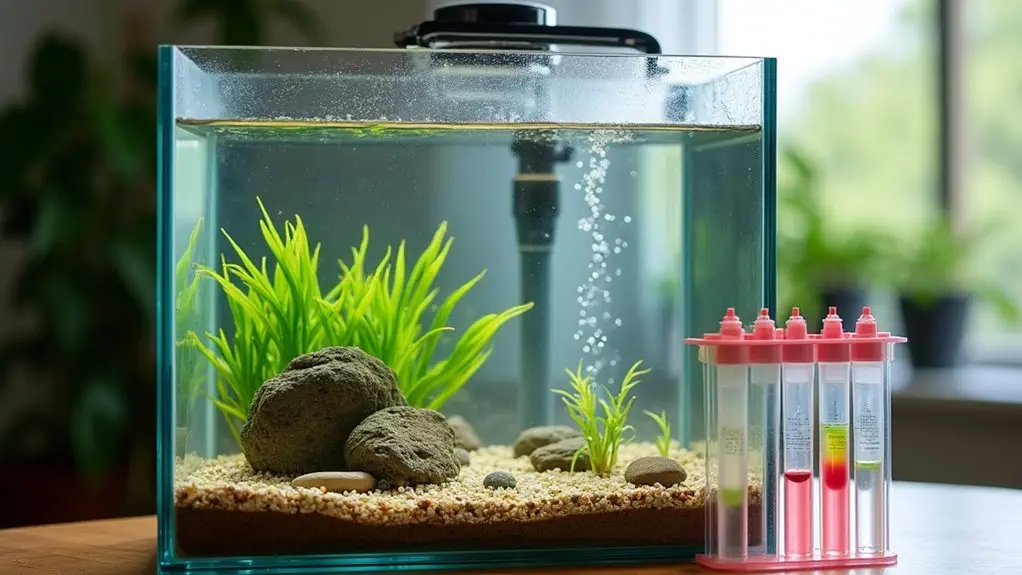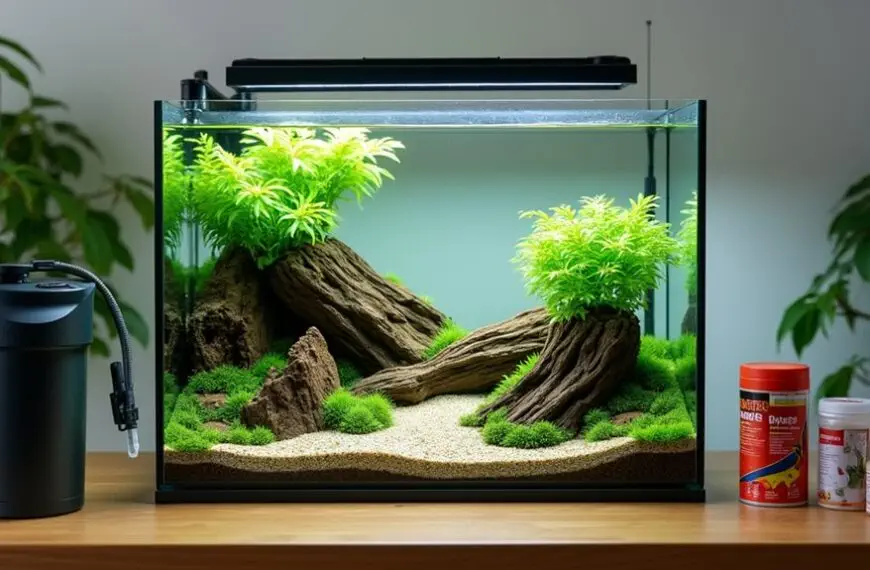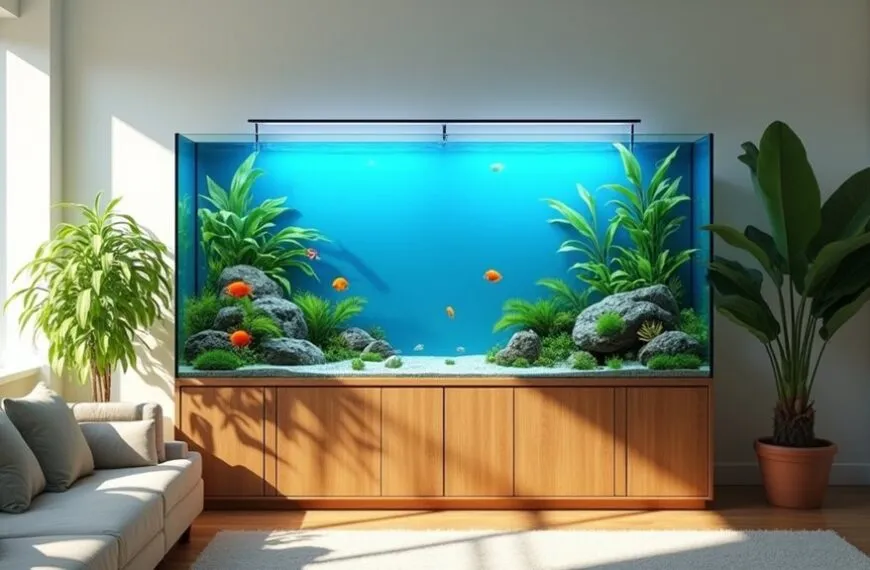Cycling your first fish tank isn’t instant—it’s about building a mini ecosystem. You’ll need to establish beneficial bacteria that convert toxic ammonia to safer nitrates, typically taking 4-6 weeks. Start with quality equipment: filter, substrate, and a reliable test kit. Monitor water parameters consistently, avoiding common mistakes like adding too many fish too soon or over-cleaning your filter. Once ammonia and nitrite levels hit zero, you’re ready to introduce fish gradually. The journey to a balanced aquarium awaits!
Contents
- 1 Understanding the Nitrogen Cycle in Aquariums
- 2 Essential Equipment for Successful Cycling
- 3 Step-by-Step Fish Tank Cycling Methods
- 4 Monitoring Water Parameters During Cycling
- 5 Common Cycling Mistakes to Avoid
- 6 Determining When Your Tank Is Fully Cycled
- 7 Adding Your First Fish After Cycling
- 8 Frequently Asked Questions
- 9 Final Thoughts
Understanding the Nitrogen Cycle in Aquariums
When you first set up your aquarium, you’re not just adding water and fish—you’re establishing a complex biological system that keeps your aquatic friends alive. This system, called the nitrogen cycle, is your tank’s natural filtration process.
Here’s what happens: Fish produce waste containing ammonia, which is toxic. Beneficial bacteria then convert this ammonia to nitrite (still harmful), and finally to nitrate (less dangerous in small amounts).
This transformation doesn’t happen overnight—it takes 4-6 weeks for these bacterial colonies to develop fully. Monitoring water parameters throughout this period ensures a stable environment for your fish.
Aquarium plants play a helpful role too, absorbing some nitrates as nutrients. They’re like nature’s filters!
Understanding this cycle is essential because adding fish before it’s complete can lead to stressed, sick, or even dead fish.
Essential Equipment for Successful Cycling
To properly establish the nitrogen cycle we just explored, you’ll need several key pieces of equipment. First, invest in a quality filter that matches your tank size. Hang-on-back filters work well for beginners, while canister filters offer more customization for larger setups.
Don’t forget, different filter types provide different benefits—sponge filters are gentle but effective for smaller tanks!
Sponge filters create a peaceful current while hosting colonies of beneficial bacteria—perfect for nano tanks and fry!
Your substrate choices matter too. Gravel or sand creates the perfect home for beneficial bacteria, with gravel allowing better water flow and sand offering a natural look.
Some specialized substrates even contain minerals that help jump-start the cycling process—pretty neat, right?
Remember to grab a reliable water test kit, thermometer, and heater too. These essentials create the stable environment your microscopic bacterial friends need to thrive and keep your future fish happy! Additionally, conducting regular water quality tests ensures that parameters remain optimal for bacterial growth throughout the cycling process.
Step-by-Step Fish Tank Cycling Methods
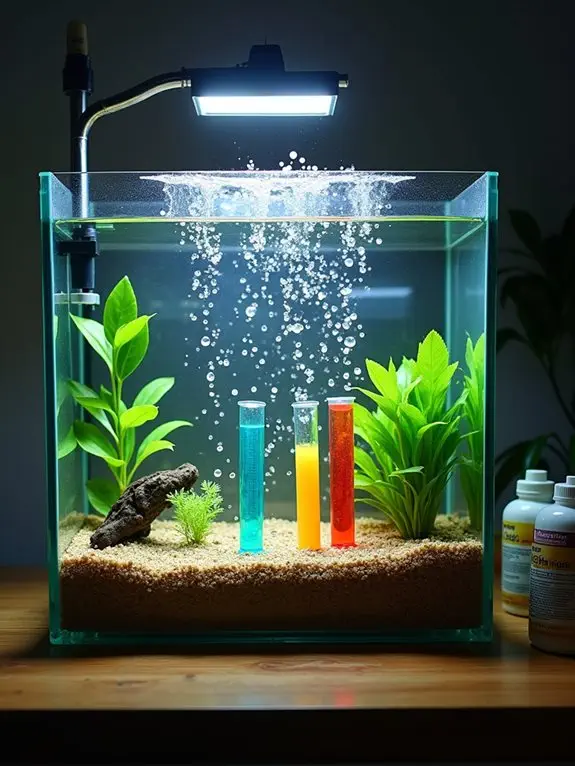
Now that you’ve gathered your equipment, let’s explore the various methods for cycling your first aquarium. There are three main approaches you can take: fishless cycling, fish-in cycling, and seeded cycling.
Fishless cycling, the most humane method, involves adding ammonia sources without stressing live fish. You’ll wait 4-6 weeks while beneficial bacteria colonies establish themselves. Pure ammonia serves as a nitrogen source during this process to support the growth of these beneficial bacteria.
Don’t fall for common cycling myths that suggest you can rush this process with additives alone!
Fish-in cycling, though traditional, places stress on fish and requires vigilant water testing and changes.
The seeded method speeds things up by borrowing established filter media or substrate from a mature tank, jumpstarting your bacterial colony.
Whichever method you choose, patience is key—those invisible beneficial bacteria need time to create your tank’s biological foundation.
Monitoring Water Parameters During Cycling
Understanding your tank’s water chemistry is the backbone of successful cycling. You’ll need to track ammonia, nitrite, and nitrate levels regularly—ideally every other day—using a reliable test kit. These readings tell you exactly where you’re in the cycling process.
Don’t forget to monitor pH levels too! Most freshwater fish thrive in a pH range of 6.5-7.5, and maintaining stability is more important than achieving a “perfect” number. If your pH fluctuates wildly, your beneficial bacteria may struggle to establish.
Proper oxygenation techniques are essential during cycling. Your filter provides some surface agitation, but consider adding an air stone if needed. Well-oxygenated water helps those hardworking bacteria colonize faster. Trust me, they’ll appreciate the extra oxygen boost while they’re setting up shop in your filter media! Additionally, ensuring that ammonia levels remain at 0 ppm is critical to prevent toxicity and promote healthy bacterial growth.
Common Cycling Mistakes to Avoid
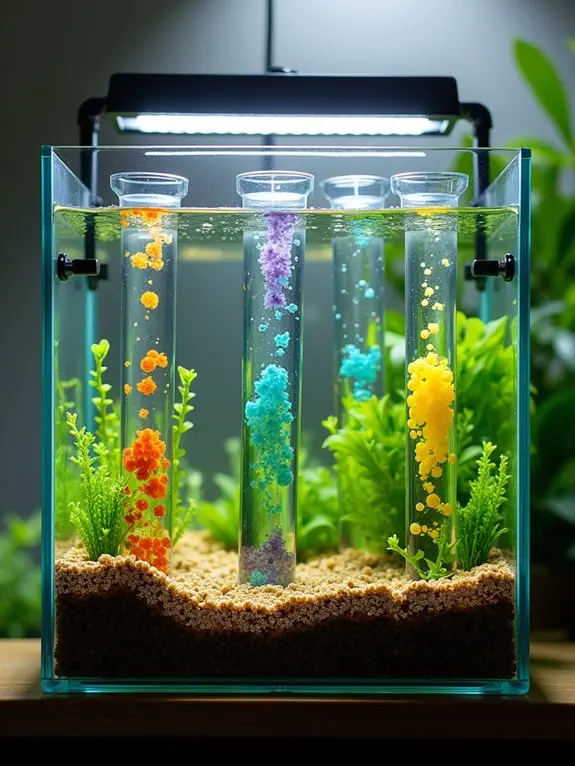
When setting up your first aquarium, even the most enthusiastic hobbyists can stumble into common pitfalls that delay the cycling process. One of the biggest misconceptions is that cycling happens quickly—in reality, the cycling timeline typically spans 4-6 weeks, not days!
Don’t rush by adding too many fish too soon. Your beneficial bacteria need time to establish, and overloading the tank disrupts this delicate process.
Similarly, changing filter media or over-cleaning during cycling washes away the very bacteria you’re trying to cultivate.
Many beginners also neglect testing regularly, assuming everything’s fine when it isn’t. Remember, you can’t see ammonia or nitrites, but they’re silently affecting your future fish.
Testing water quality parameters regularly is crucial to monitor levels of ammonia, nitrites, and nitrates, which can significantly affect the health of your aquarium.
Patience truly is your best friend here—those extra weeks of waiting now mean years of a healthy, thriving aquarium later.
Determining When Your Tank Is Fully Cycled
You’ll know your tank has fully cycled when ammonia and nitrite levels drop to zero while nitrates begin to appear in your water tests.
For confident results, you should test your water parameters daily for at least a week to confirm these readings remain stable. This stability means your beneficial bacteria colony is established and robust enough to handle the waste produced by your fish, signaling you’re ready to add more aquatic friends to your new underwater world. Additionally, maintaining the ideal pH range is crucial for ensuring a healthy environment for your fish.
Testing Ammonia and Nitrates
Knowing exactly when your tank has completed the cycling process requires regular testing of both ammonia and nitrate levels.
You’ll need a reliable test kit that can measure these vital parameters with accuracy. Remember, ammonia sources include fish waste, uneaten food, and decaying plant matter—all of which contribute to the nitrogen cycle.
Test your water twice weekly during cycling. You’re looking for ammonia to spike first (showing bacterial activity), then drop to zero as nitrites rise, and finally, you’ll see nitrates accumulate. Regular testing is essential to ensure stable living conditions for your fish throughout this process.
Nitrate reduction becomes your next focus once cycling completes. When ammonia and nitrites consistently read zero while nitrates are present, congratulations—your tank has cycled!
Don’t rush this process; it typically takes 4-6 weeks for beneficial bacteria to establish fully.
Stability Over Time
The true mark of a fully cycled tank isn’t just a single zero reading, but consistent stability over multiple weeks.
Your tank has achieved biological balance when water quality parameters remain steady without frequent intervention. Think of it as your aquatic ecosystem finding its rhythm—a delicate dance of beneficial bacteria keeping ammonia and nitrites in check.
How do you know you’ve reached this milestone? Look for these signs:
- Ammonia and nitrite readings consistently at 0 ppm for at least two weeks
- Nitrate levels that increase gradually and predictably
- pH remaining stable without dramatic swings
- Fish showing healthy behavior with no signs of stress
Additionally, maintaining optimal water quality will further support the health and longevity of your fish.
Adding Your First Fish After Cycling
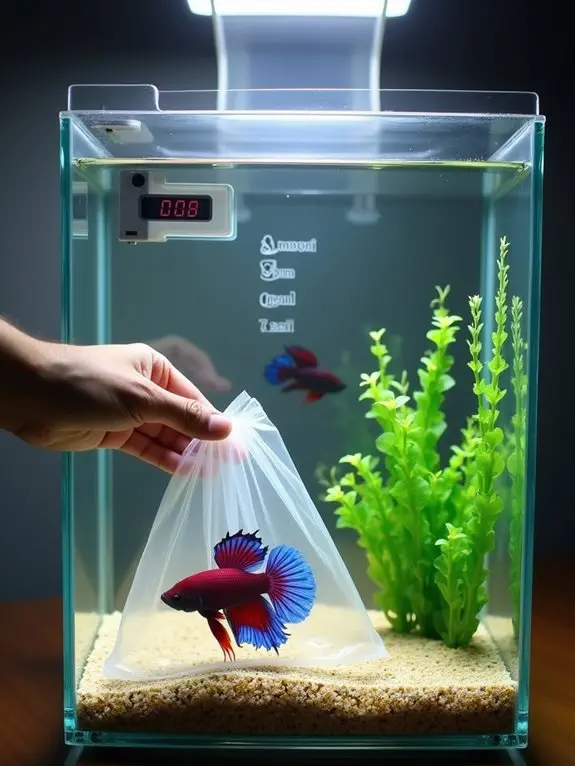
After successfully cycling your tank, it’s finally time to introduce some fish to their new home! This exciting step requires careful fish selection to guarantee your aquatic friends will thrive in their new environment.
Start with hardy species and add just a few fish at first—your biofilter needs time to adjust to the new bioload.
The acclimation process is vital for your fish’s survival. Don’t just dump them in! Instead, float the bag in your tank for 15-20 minutes to equalize temperatures, then gradually add small amounts of your tank water to their bag over 30 minutes.
This helps them adjust to the water chemistry differences. Once acclimated, gently transfer the fish—not the store water—into your tank. Additionally, selecting hardy species like goldfish or guppies can greatly enhance the chances of initial success.
Frequently Asked Questions
Can I Speed up Cycling Using Filter Media From Established Tanks?
Yes, you can markedly speed up cycling by using filter media from established tanks. This bacteria transfer immediately introduces beneficial microorganisms to your new setup, jumpstarting the process that would otherwise take weeks.
Will Live Plants Affect the Nitrogen Cycle Process?
Yes, live plants benefit your cycling process by absorbing ammonia and nitrates directly, reducing cycling time. They’ll also compete with algae growth, keeping your tank cleaner while the nitrogen cycle establishes itself.
Does Aquarium Size Impact Cycling Time?
Yes, larger tank dimensions generally give you longer cycling duration. However, you’ll find that tank size affects cycling less than bacterial population growth rates, which depend on ammonia levels and filtration capacity.
Is Fishless Cycling Better Than Cycling With Hardy Fish?
Yes, fishless cycling is better as it doesn’t stress any fish health. You’ll maintain control over ammonia levels without risking living creatures. It’s more humane and provides the same biological benefits for your tank.
Can I Use My Tap Water Without Treating It First?
You shouldn’t use untreated tap water as it contains harmful chlorine levels that can kill beneficial bacteria and harm fish. Always treat your water with a conditioner to neutralize tap water quality issues first.
Final Thoughts
You’ve made it through the tank cycling journey, and that’s worth celebrating! Remember, patience truly pays off in the aquarium hobby. By understanding the nitrogen cycle, using proper equipment, and monitoring water parameters, you’ve created a healthy home for your future aquatic friends. Don’t rush adding those first fish—they’ll thank you with vibrant colors and active swimming. Welcome to the wonderful world of fishkeeping, you’re officially part of the club!

